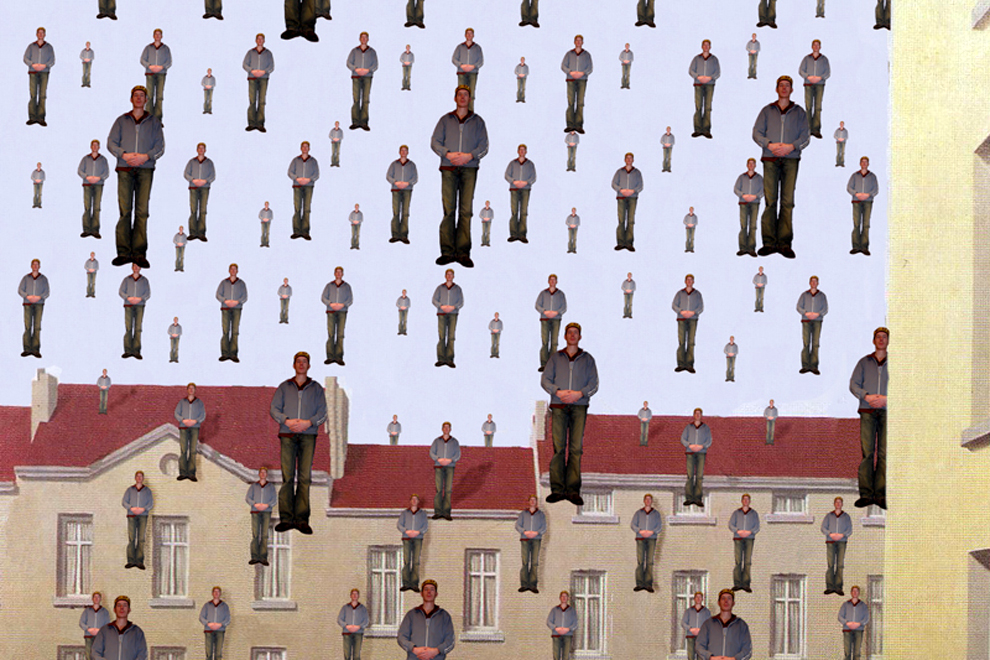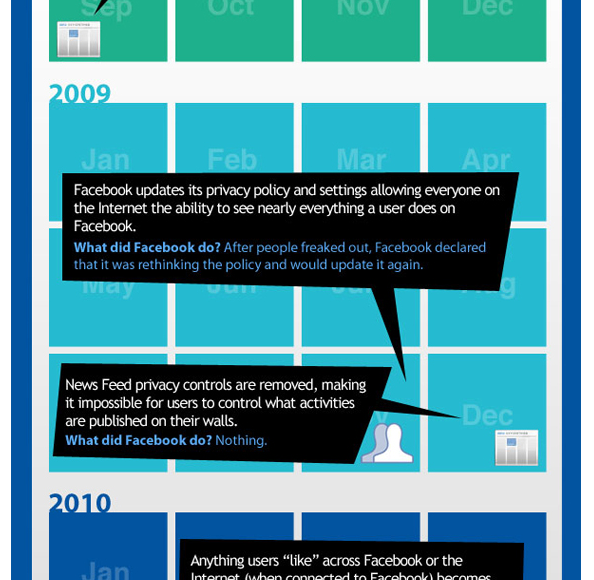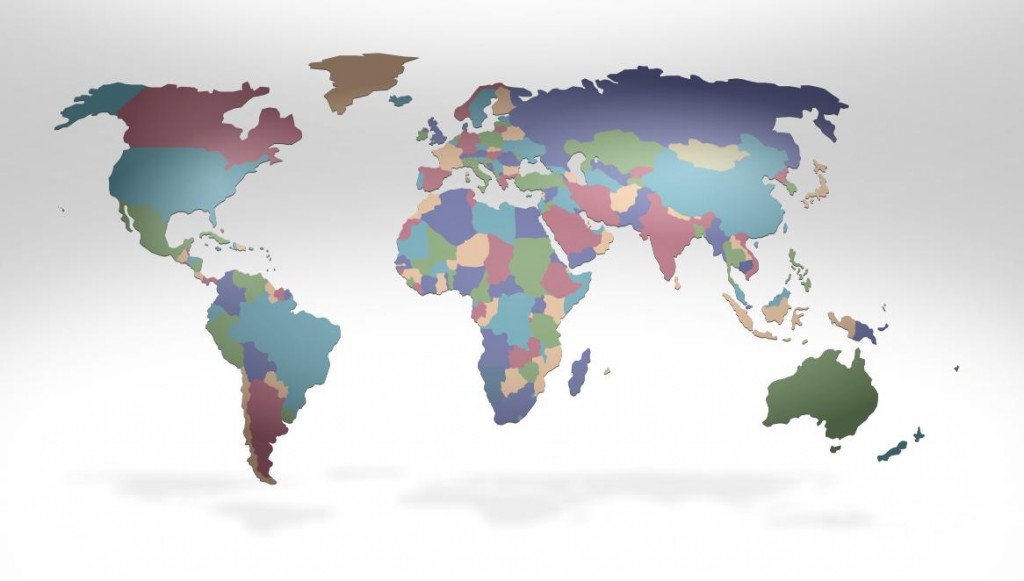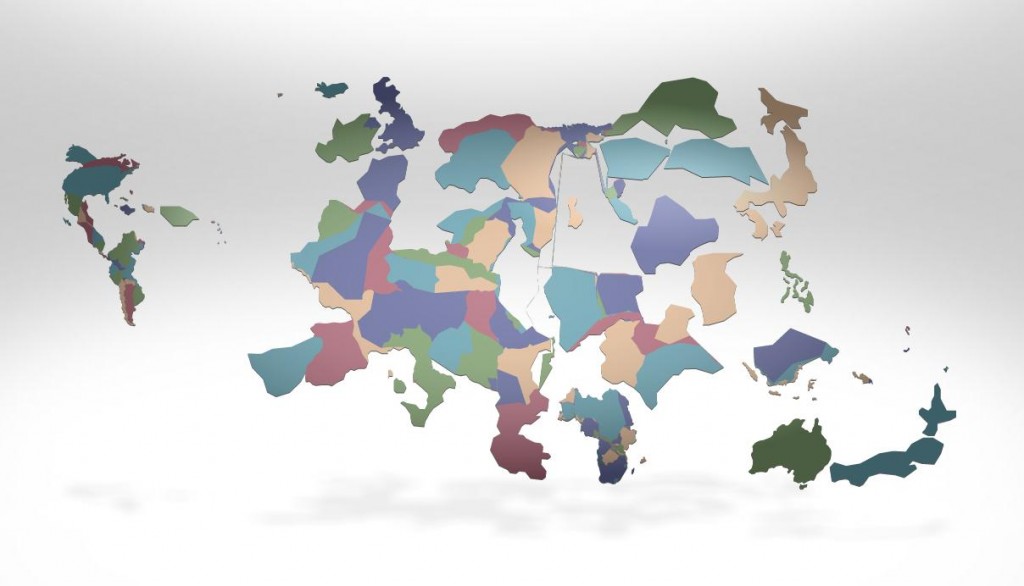Facebook
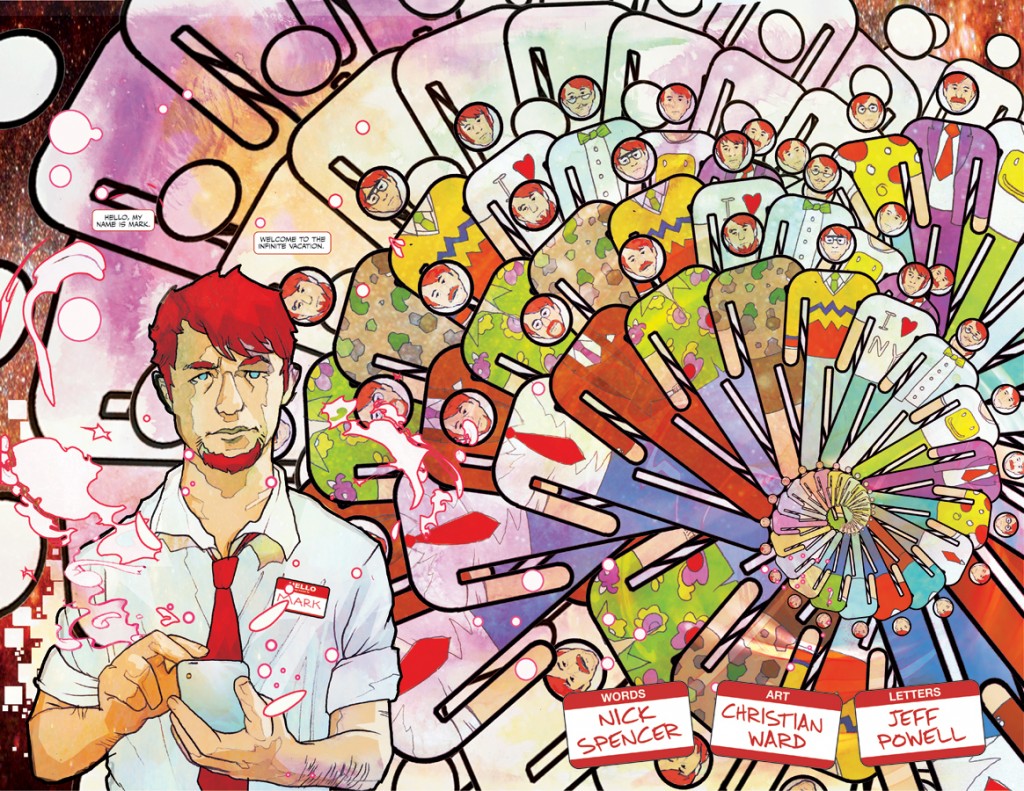 While the tide is turning, comics are still an under-appreciated medium in 2011. This despite increased interest in superheroes given the Hollywood treatment and critical attention to thoughtful indie pieces like Fun Home and Love and Rockets. It’s a shame because comics’ juxtaposed panels, their special way of framing time in terms of space, are well equipped to address those intersections of identity, technology, and visual representation that get so much play in mainstream and academic press. Image Comics’ Infinite Vacation is one new ongoing title that tackles those ideas head on.
While the tide is turning, comics are still an under-appreciated medium in 2011. This despite increased interest in superheroes given the Hollywood treatment and critical attention to thoughtful indie pieces like Fun Home and Love and Rockets. It’s a shame because comics’ juxtaposed panels, their special way of framing time in terms of space, are well equipped to address those intersections of identity, technology, and visual representation that get so much play in mainstream and academic press. Image Comics’ Infinite Vacation is one new ongoing title that tackles those ideas head on.
Writer Nick Spencer is a rising star whose big hit, Morning Glories, blends teenage drama with the surreal paranoia of 60s TV thriller The Prisoner. In Infinite Vacation, Spencer teams with artist Christian Ward to tell the story of Mark, daily user of a ubiquitous, near-future technology which allows anyone to buy or sell their existence in parallel universes through a smartphone app; for $25,000 Mark can become the hero cop version of himself, and it’ll cost at least $3000 for him to become a Mark who did not just get walked out on by that mystery girl in the coffee shop.
Mark is a cyborg less like Robocop and more like the average Facebook user who presents their preferred self to the world via an array of edited images, clicked “likes”, and comments with friends (i.e., exactly how Cyborgology editors define the cyborg in their inaugural post). Identity definition and presentation through web spaces and consumer devices is a major theme in Infinite Vacation, whether it’s the RSS feed of your alternate selves’ lives and deaths or that mystery girl saying, “That thing in your hand isn’t worth shit to me…” when Mark tries to prove his seriousness by showing how expensive his app-assisted reality purchase would have been. A gorgeous opening spread (below) has infinite Marks fitted into generic male outlines, reminiscent of your chosen profile picture replacing the pale blue Facebook default. more...
This post originally appeared on one of our favorite blogs, OWNI, 25 January, 2011. 
Without indulging into the theories developed by radical sociobiologists, we can reasonably hypothesize that the development of the ego, vanity, and a sense of self-importance were more or less the result of evolutionary adaptations needed for our species’ survival.
THE NATURAL NEED TO EMERGE FROM THE CROWD
In prehistoric times, group survival depended on the level of strength and stamina individuals had in an insecure world where they were powerless against nature. They had to be strong enough to persevere over harsh weather conditions, long migrations, and other dangers in this savage world. They also had to be fit enough to compete against other males for females, thus perpetuating their contribution to the gene pool.
More than just mere strength was needed for survival: The cohesion and solidarity of the groupallowed people to defend themselves against larger animals and organize collective hunts. In turn the group provided food security for everyone, justifying why collective actions were instated as an efficient method for survival. more...
 Last week, I posted a review of the film Tron: Legacy (2010) on this blog. This week I have a review of Ondi Timoner‘s wonderful 2009 documentary We Live in Public. This review is found in the latest issue of one of my favorite journals, Surveillance and Society.
Last week, I posted a review of the film Tron: Legacy (2010) on this blog. This week I have a review of Ondi Timoner‘s wonderful 2009 documentary We Live in Public. This review is found in the latest issue of one of my favorite journals, Surveillance and Society.
The issue is here. Free .pdf download of the review here.
I explore theoretical connections between the movie and the rise of social network sites such as Facebook. I look at privacy, publicity, surveillance and our increasingly augmented reality. Many of the points are elaborations of topics posted by myself and others on this blog. It is particularly exciting to see these theoretical ideas travel so smoothly across mediums such as film, radio, the blogosphere and academic journals.
 Cyborgology editors Nathan Jurgenson and PJ Rey discuss the social media connections to this tragedy. The complete interview is now streaming (interview starts at 2:03).
Cyborgology editors Nathan Jurgenson and PJ Rey discuss the social media connections to this tragedy. The complete interview is now streaming (interview starts at 2:03).
 On Jan. 8, 2011, Jared Lee Loughner allegedly shot Congresswoman Gabrielle Giffords (D-AZ) and 19 others resulting in 6 fatalities. This event has drawn attention to a number of new and important roles social media has come to play in our society, including how information is gathered, changed political rhetoric, and how these sites handle the profiles of those involved in high-profile tragedies.
On Jan. 8, 2011, Jared Lee Loughner allegedly shot Congresswoman Gabrielle Giffords (D-AZ) and 19 others resulting in 6 fatalities. This event has drawn attention to a number of new and important roles social media has come to play in our society, including how information is gathered, changed political rhetoric, and how these sites handle the profiles of those involved in high-profile tragedies.
Profiling the Suspect
Media coverage (i.e., cable, network, radio, and newspapers) of the event represented a broader trend in contemporary journalism: almost immediately, news outlets began to piece together a profile of this previously unknown figure using almost exclusively Loughner’s social media profiles (i.e., Facebook, Myspace, Youtube and, most recently, online gaming discussion boards). Even though his MySpace and Facebook profiles were taken down by the site, screenshots of the sites are available, including one showing a photo of gun on a US History textbook as a profile picture.
The digital documentation of our lives via social media offers an easily-accessible, autobiographical source for journalists and anyone else who is interested. Yet, there is a risk in basing our impressions solely off of this information. Loughner’s image of himself is certainly not objective and may very well be inaccurate. News outlets, however, face pressure to “get the scoop” on the story, so they tended to report on Loughner based heavily on this information, as opposed to interviewing a range of people in his life to construct a more holistic perspective.
The Post-Shooting Political Debate
In the wake of the tragedy, a debate emerged over the intensity and tone of contemporary political rhetoric. The political right in general, and Sarah Palin in particular, more...
Fed-Ex has created an interactive global data experience on their website to offer “customers intriguing and insightful information to help them stay ahead of their customers’ needs in a continually changing world” (quote is from here). Putting aside the business speak, some of the data and especially its presentation is indeed intriguing. For instance, here is the globe with countries sized, as usual, by geographic size.
Next, we can have the size of the countries displayed based on all sorts of things. Below they are sized by access to the mobile web:
 Wonderful new cover story from the New York Times Magazine about death on Facebook. Read it here.
Wonderful new cover story from the New York Times Magazine about death on Facebook. Read it here.
Yes, even a CGI-filled big-budget glowing Disney spectacle can provide opportunity for theorization. Of the recent Internet-themed blockbusters – namely, Avatar (2009); The Social Network (2010) – Tron: Legacy (2010) best captures the essence of this blog: that the digital and the physical are enmeshed together into an augmented reality.
This seems surprising given that the film is premised on the existence of a separate digital world. Indeed, the first Tron (1982) is all about a strict physical-digital dualism and the sequel plays on the same theme: physical person gets trapped in a digital world and attempts to escape. However, Tron: Legacy explores the overlapping of the physical and digital. The story goes that Flynn, the hero from the 1982 film, develops a digital world that does not have the imperfections of its physical counterpart. His grand vision was to gloriously move humanity online. Simultaneously, the beings in the digital world want to export their perfection out of the digital world and to colonize the offline world, removing all of its imperfections (i.e., us). Flynn comes to realize that enforced perfection (read: Nazism) is unwanted. Instead of a highly controlled and orderly universe, what has to be appreciated is what emerges out of chaos. And it is here that the film makes at least two theoretical statements that are well ahead of most movies and popular conceptions of the digital.
First is the tension between more...
 While the tide is turning, comics are still an under-appreciated medium in 2011. This despite increased interest in superheroes given the Hollywood treatment and critical attention to thoughtful indie pieces like Fun Home and Love and Rockets. It’s a shame because comics’ juxtaposed panels, their special way of framing time in terms of space, are well equipped to address those intersections of identity, technology, and visual representation that get so much play in mainstream and academic press. Image Comics’ Infinite Vacation is one new ongoing title that tackles those ideas head on.
While the tide is turning, comics are still an under-appreciated medium in 2011. This despite increased interest in superheroes given the Hollywood treatment and critical attention to thoughtful indie pieces like Fun Home and Love and Rockets. It’s a shame because comics’ juxtaposed panels, their special way of framing time in terms of space, are well equipped to address those intersections of identity, technology, and visual representation that get so much play in mainstream and academic press. Image Comics’ Infinite Vacation is one new ongoing title that tackles those ideas head on.
Writer Nick Spencer is a rising star whose big hit, Morning Glories, blends teenage drama with the surreal paranoia of 60s TV thriller The Prisoner. In Infinite Vacation, Spencer teams with artist Christian Ward to tell the story of Mark, daily user of a ubiquitous, near-future technology which allows anyone to buy or sell their existence in parallel universes through a smartphone app; for $25,000 Mark can become the hero cop version of himself, and it’ll cost at least $3000 for him to become a Mark who did not just get walked out on by that mystery girl in the coffee shop.
Mark is a cyborg less like Robocop and more like the average Facebook user who presents their preferred self to the world via an array of edited images, clicked “likes”, and comments with friends (i.e., exactly how Cyborgology editors define the cyborg in their inaugural post). Identity definition and presentation through web spaces and consumer devices is a major theme in Infinite Vacation, whether it’s the RSS feed of your alternate selves’ lives and deaths or that mystery girl saying, “That thing in your hand isn’t worth shit to me…” when Mark tries to prove his seriousness by showing how expensive his app-assisted reality purchase would have been. A gorgeous opening spread (below) has infinite Marks fitted into generic male outlines, reminiscent of your chosen profile picture replacing the pale blue Facebook default. more...
This post originally appeared on one of our favorite blogs, OWNI, 25 January, 2011. ![]()
Without indulging into the theories developed by radical sociobiologists, we can reasonably hypothesize that the development of the ego, vanity, and a sense of self-importance were more or less the result of evolutionary adaptations needed for our species’ survival.
THE NATURAL NEED TO EMERGE FROM THE CROWD
In prehistoric times, group survival depended on the level of strength and stamina individuals had in an insecure world where they were powerless against nature. They had to be strong enough to persevere over harsh weather conditions, long migrations, and other dangers in this savage world. They also had to be fit enough to compete against other males for females, thus perpetuating their contribution to the gene pool.
More than just mere strength was needed for survival: The cohesion and solidarity of the groupallowed people to defend themselves against larger animals and organize collective hunts. In turn the group provided food security for everyone, justifying why collective actions were instated as an efficient method for survival. more...
 Last week, I posted a review of the film Tron: Legacy (2010) on this blog. This week I have a review of Ondi Timoner‘s wonderful 2009 documentary We Live in Public. This review is found in the latest issue of one of my favorite journals, Surveillance and Society.
Last week, I posted a review of the film Tron: Legacy (2010) on this blog. This week I have a review of Ondi Timoner‘s wonderful 2009 documentary We Live in Public. This review is found in the latest issue of one of my favorite journals, Surveillance and Society.
The issue is here. Free .pdf download of the review here.
I explore theoretical connections between the movie and the rise of social network sites such as Facebook. I look at privacy, publicity, surveillance and our increasingly augmented reality. Many of the points are elaborations of topics posted by myself and others on this blog. It is particularly exciting to see these theoretical ideas travel so smoothly across mediums such as film, radio, the blogosphere and academic journals.
 Cyborgology editors Nathan Jurgenson and PJ Rey discuss the social media connections to this tragedy. The complete interview is now streaming (interview starts at 2:03).
Cyborgology editors Nathan Jurgenson and PJ Rey discuss the social media connections to this tragedy. The complete interview is now streaming (interview starts at 2:03).
 On Jan. 8, 2011, Jared Lee Loughner allegedly shot Congresswoman Gabrielle Giffords (D-AZ) and 19 others resulting in 6 fatalities. This event has drawn attention to a number of new and important roles social media has come to play in our society, including how information is gathered, changed political rhetoric, and how these sites handle the profiles of those involved in high-profile tragedies.
On Jan. 8, 2011, Jared Lee Loughner allegedly shot Congresswoman Gabrielle Giffords (D-AZ) and 19 others resulting in 6 fatalities. This event has drawn attention to a number of new and important roles social media has come to play in our society, including how information is gathered, changed political rhetoric, and how these sites handle the profiles of those involved in high-profile tragedies.
Profiling the Suspect
Media coverage (i.e., cable, network, radio, and newspapers) of the event represented a broader trend in contemporary journalism: almost immediately, news outlets began to piece together a profile of this previously unknown figure using almost exclusively Loughner’s social media profiles (i.e., Facebook, Myspace, Youtube and, most recently, online gaming discussion boards). Even though his MySpace and Facebook profiles were taken down by the site, screenshots of the sites are available, including one showing a photo of gun on a US History textbook as a profile picture.
The digital documentation of our lives via social media offers an easily-accessible, autobiographical source for journalists and anyone else who is interested. Yet, there is a risk in basing our impressions solely off of this information. Loughner’s image of himself is certainly not objective and may very well be inaccurate. News outlets, however, face pressure to “get the scoop” on the story, so they tended to report on Loughner based heavily on this information, as opposed to interviewing a range of people in his life to construct a more holistic perspective.
The Post-Shooting Political Debate
In the wake of the tragedy, a debate emerged over the intensity and tone of contemporary political rhetoric. The political right in general, and Sarah Palin in particular, more...
Fed-Ex has created an interactive global data experience on their website to offer “customers intriguing and insightful information to help them stay ahead of their customers’ needs in a continually changing world” (quote is from here). Putting aside the business speak, some of the data and especially its presentation is indeed intriguing. For instance, here is the globe with countries sized, as usual, by geographic size.
Next, we can have the size of the countries displayed based on all sorts of things. Below they are sized by access to the mobile web:
 Wonderful new cover story from the New York Times Magazine about death on Facebook. Read it here.
Wonderful new cover story from the New York Times Magazine about death on Facebook. Read it here.
Yes, even a CGI-filled big-budget glowing Disney spectacle can provide opportunity for theorization. Of the recent Internet-themed blockbusters – namely, Avatar (2009); The Social Network (2010) – Tron: Legacy (2010) best captures the essence of this blog: that the digital and the physical are enmeshed together into an augmented reality.
This seems surprising given that the film is premised on the existence of a separate digital world. Indeed, the first Tron (1982) is all about a strict physical-digital dualism and the sequel plays on the same theme: physical person gets trapped in a digital world and attempts to escape. However, Tron: Legacy explores the overlapping of the physical and digital. The story goes that Flynn, the hero from the 1982 film, develops a digital world that does not have the imperfections of its physical counterpart. His grand vision was to gloriously move humanity online. Simultaneously, the beings in the digital world want to export their perfection out of the digital world and to colonize the offline world, removing all of its imperfections (i.e., us). Flynn comes to realize that enforced perfection (read: Nazism) is unwanted. Instead of a highly controlled and orderly universe, what has to be appreciated is what emerges out of chaos. And it is here that the film makes at least two theoretical statements that are well ahead of most movies and popular conceptions of the digital.
First is the tension between more...


